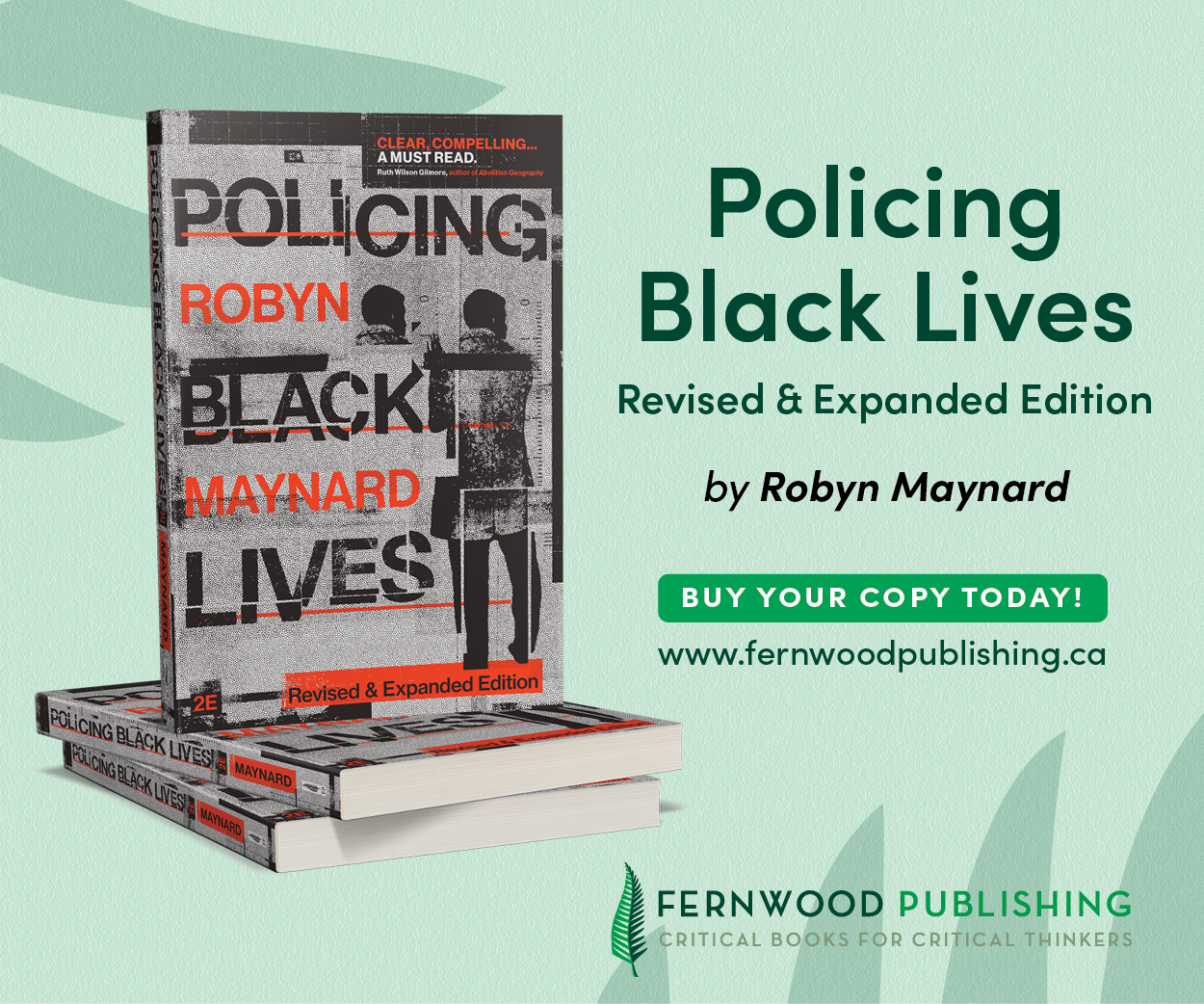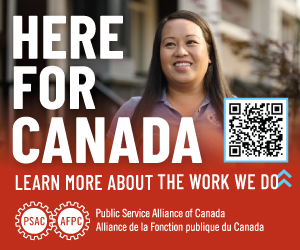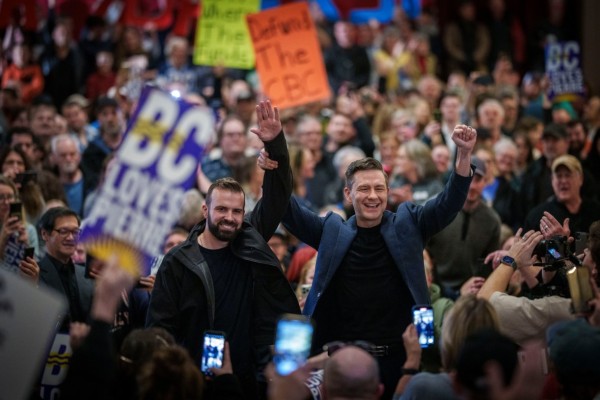‘Flooding the zone’ with residential school denialism
In conversation about the far-right’s strategy to undermine truth and reconciliation
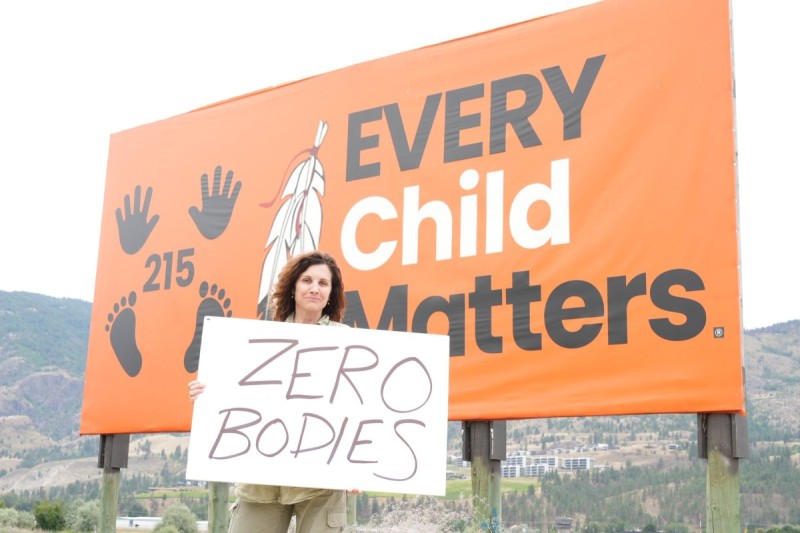
Vancouver–Quilchena MLA Dallas Brodie was expelled from the BC Conservative caucus after mocking residential school survivor testimony in a podcast appearance. Photo courtesy Dallas Brodie/X.
In light of BC MLA Dallas Brodie’s persistent residential school denialism—most recently through inflammatory comments on Orange Shirt Day and the promotion of a new propaganda film about residential schooling—it’s important to understand these actions as part of a broader far-right strategy.
Brodie and other residential school denialists are adopting the American far-right tactic of “flooding the zone”: overwhelming public discourse with misinformation and disinformation to erode public confidence in truth and reconciliation efforts and to defend the settler-capitalist status quo.
To help people better recognize this strategy, I joined the Redeye podcast to discuss why Brodie’s recent “zero bodies” rhetoric is yet another far-right distraction aimed at stoking anti-Indigenous hatred for political gain. As I argue in the transcript below, we share an ethical responsibility to confront and counter this harmful wave of residential school denialism.
Redeye (RE): This is the Redeye Podcast. You can hear our live broadcast on Saturday mornings from 10 till noon PST at 100.5 FM in the Lower Mainland in British Columbia.
In this episode, I’m joined by Sean Carleton to talk about who’s behind residential school denialism and the best way to counter it. Recently, the MLA for Vancouver–Quilchena, Dallas Brodie, reposted a National Post article about the former residential school site in Kamloops, adding a comment that the number of confirmed child burials at the site is “zero.” The National Post article is about James Heller, who pushed the Law Society of BC to change its training material to say that there were potentially burial sites at the former residential school in Kamloops instead of more definitive language.
Brodie is only one of a number of conservatives who have questioned the history of residential school abuse. To discuss these comments and their impact on truth and reconciliation, I’m joined by Sean Carleton, Associate Professor of History and Indigenous Studies at the University of Manitoba. Hello, Sean.
Sean Carleton (SC): Good morning, thanks for having me.
RE: I’m really happy you could join us today. What point are Dallas Brodie and James Heller making about the Kamloops residential school site?
SC: Well, I think what people really need to understand is that both Brodie and Heller, like other residential school denialists, are trying to use the issue of Kamloops as a wedge issue. If you look at the National Post article that Brodie tweeted out with the following statement, she says, “The number of confirmed child burials at the former Kamloops Indian residential school site is zero. Zero. No one should be afraid of the truth, not lawyers, their governing bodies or anyone else.” This is the tweet that has caused this uproar.
The issue is that, of course, the Kamloops investigation into potential unmarked burials at the former Kamloops residential school site is ongoing. They have not actually finished that investigation. And so, what they’re trying to do, based on sort of a right-wing strategy of trying to deflect or distract public attention, is they’re trying to suggest that there actually are no deaths at the Kamloops residential school, and that they’re not going to confirm deaths, and that the entire residential school system and truth around residential schools is being overblown. People are being misled by the media and First Nations.
What they’re trying to do, then, is shake public confidence in the Kamloops situation. And of course, this is coming about because there is a lot of confusion about the Kamloops announcement.
The number of confirmed child burials at the former Kamloops Indian Residential School site is zero.
— Dallas Brodie (@Dallas_Brodie) February 22, 2025
Zero.
No one should be afraid of the truth. Not lawyers, their governing bodies, or anyone else. 1/3https://t.co/ymtHLhdmZn
RE: What did the investigators say about what they found at that school site so far?
SC: In their original statement in May of 2021, the Nation said, quote, “this past weekend, with the help of ground penetrating radar specialists, the stark truth of the preliminary findings came to light. The confirmation of the remains of 215 children who were students at the Kamloops Indian Residential School.” Now, that statement goes on to explain that ground penetrating radar is only used to identify soil anomalies, confirming prior community knowledge about additional deaths that happened at the schools that may, in fact, be buried at the school.
People read this statement, and not understanding the nature of the investigation, where they were using historical research, oral testimony from survivors, and ground penetrating radar, that the pattern of evidence suggested that there were anomalies consistent with what might be burials. People just thought they had found bodies. But that’s actually not what the Nation said.
Although there was some initial confusion about the nature of the findings, officials later clarified that they likely indicated the presence of burials. But again, people didn’t quite understand. And so, what people like Brodie and others are doing is saying, “you promised us bodies. And unless there are bodies, then all of this is made up.” And that’s what they’re trying to do. They’re seizing on confusion or even minor errors made by the media, misrepresenting what the Nation is actually saying and what their investigation is confirming.
In the years since, particularly on the far-right, some have sought to challenge the Kamloops investigation, basically saying, if you can’t show us the bodies of children, then all of this “residential school business,” as BC MLA Brent Chapman said in an interview while he was running for recent election, is just a “hoax.”
Kamloops residential school in 1930.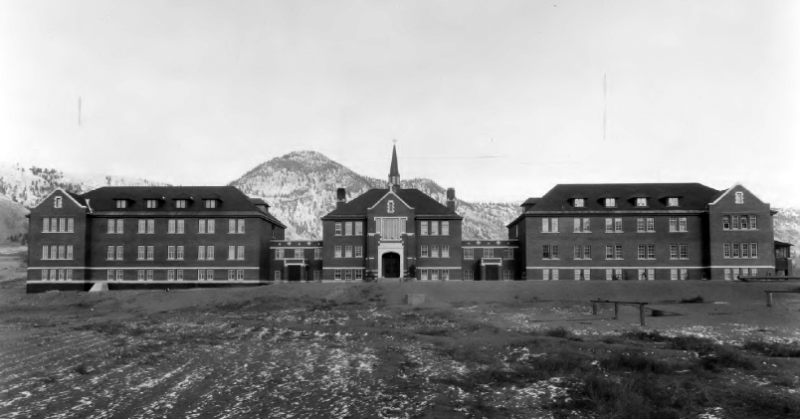
RE: And yet, there are sites where evidence is much, much harder to deny in BC, is that correct?
SC: This is the issue that’s so frustrating. We already know that more than 4,000 children died at residential schools, 50 plus at the Kamloops residential school, confirmed by church and state records. I’ve been seeing lots of people posting online supporting Brodie saying, since 2021 zero bodies, zero deaths have been confirmed. That is incorrect. Actually, Williams Lake First Nation, as a result of the Kamloops announcement, launched their own investigation, and they’ve just released their preliminary results that, regardless of what they might find using ground penetrating radar, thanks to working with the Oblates and getting access to over 60,000 new records that had been withheld, the death rate in that school confirmed by those sources is three times higher than what the Truth and Reconciliation Commission reported in 2015.
So, we know that there are more deaths than were recorded and made available to the Truth and Reconciliation Commission.
RE: How widespread is residential school denialism in Canada?
SC: It’s more widespread than people realize. You know, it grows on the extreme far-right. Those connected to Rebel News, True North, Western Standard, and organizations like the Frontier Centre for Public Policy.
They’ve been pumping out misinformation about residential schooling, trying to minimize, downplay, twist, distort basic facts, at least since the beginning of the Truth and Reconciliation Commission. It’s a barrage of misinformation.
In doing this, they’re engaging in a right-wing strategy known as “flooding the zone”, which is just bombarding their networks with this kind of information. If people do a quick search on any of those sites, you will see that they are publishing stories on residential schools regularly.
It’s constant, and that’s the point. The goal is to convince people of this misinformation so that it can get distributed up the far-right media food chain. So, denialism has jumped from these extreme right-wing sources now to elected politicians.
People like Brodie, yes, but also Danielle Smith, the premier of Alberta, and others on the more mainstream right. And of course, the danger of the “flooding the zone” strategy is that when there’s so much of this information out there, it starts to seem legitimate. It begins to move the goalposts and shape what people actually believe, which is why they’re doing it and why this lawyer and others continue to be obsessed with trying to delegitimize the Kamloops investigation, and all others, as part of a larger residential school denialist strategy.
Memorial for the Kamloops residential school, Vancouver, May 30, 2021. Photo by GoToVan/Flickr.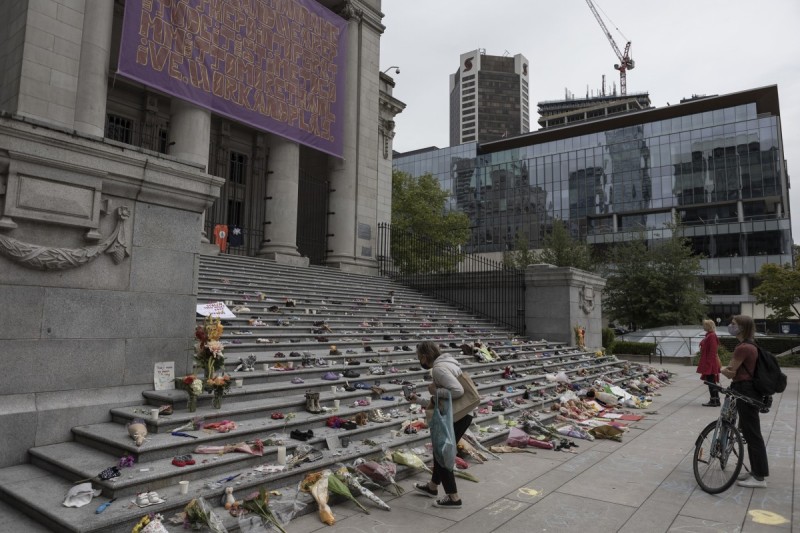
RE: What’s the best way for people who support the work of truth and reconciliation to respond to statements like these?
SC: The first thing is that we need to be educated about these issues. I’ve seen some people responding to Brodie saying, well, there have been bodies confirmed at Kamloops, which is actually the trap that she’s laying. And she’s not original, she’s not the first person to do this.
She’s learning from others who have set this foundation and shown people how to do this. You basically say something inflammatory, but that is technically or narrowly correct, and disconnected from the larger context. And then if people double down on it, then you can say, see, people have lost the plot, they’re wrong. It’s a trap.
We need to be educated about what’s really going on. We need to understand the full complexity of the Kamloops situation, what the Nation is saying. We need to understand Kamloops not in a bubble or in isolation. We need to understand it in the context of ongoing investigations by other schools, other Nations across the country that have confirmed additional deaths that were not known by the Truth and Reconciliation Commission, which is why all of these Nations started this in the first place. They’re not doing the work to prove to Canadians the truth of residential schooling. We already know that truth.
Whether additional deaths are confirmed or not, the Truth and Reconciliation Commission has laid out clearly the evidence that this was a genocidal system. We’re not going back from that. Denialists are trying to shake public confidence in that by engaging in these disingenuous strategies of trying to twist, downplay, catch people out, pounce on errors that people make.
Again, this is just a copy and paste of the right-wing American playbook. To try and gain political control through discursive forms. So this is what I think people need to know.
First, they need to know that this is part of a strategy of residential school denialism. Now, let me just clarify. Residential school denialism is not the denial of the residential school system’s existence or even that it had some negative effects.
Rather, denialism, like other kinds of denialism that we are seeing proliferate in our age of misinformation and disinformation, like science denialism, vaccine denialism, is a strategy to shake public confidence in something by twisting, distorting, downplaying basic facts about it.
In this case, what denialists are doing is they’re trying to use the confusing nature of things like ground penetrating radar or the fact that most Canadians are not paying attention to the intricacies of what Nations are actually announcing in their preliminary reports and investigations. They’re trying to twist information and hive off support for truth and reconciliation by suggesting that it is a hoax.
They’re trying to argue that everyone’s being misled, and we should really just go back to thinking that the system was well-intentioned. It was “of the times.” Abuse is being exaggerated. Deaths didn’t happen or they were inevitable. Once people understand that these kinds of comments, these kinds of strategies are being used deliberately, pushed out deliberately by the same characters, then we can start to understand them as denialism and begin to think, okay, so our goal is actually not just to learn about residential school truth. We also need to learn how to defend that truth from denialism. So, we have to learn the basic talking points.
We need to understand what the strategy is so that we don’t respond to people like Brodie by saying “you’re wrong,” because she’s actually right in a very narrow sense. She’s trying to focus very narrowly out of context on this one issue, while ignoring the larger context that the investigation is not over. So why are we doing this? And also, that if the issue is that Canadians are frustrated that additional deaths haven’t been confirmed and that all of this is a hoax, that is actually wrong.
Even in British Columbia, additional deaths have been confirmed at schools across the province. So what Brodie’s trying to do is use this as a wedge, and that is part of the strategy of flooding the zone with residential school denialism.
People know that it’s wrong. They know that Brodie has a pattern of anti-Indigenous racism. But she’s hoping that people won’t be able to respond in the clearest way, and then they can actually use those responses to further double down on pushing denialism as a way of undermining Kamloops or Indigenous people and attack truth and reconciliation generally to protect the settler capitalist status quo, which is their ultimate end-game.
RE: Thank you so much for speaking with me today, Sean.
This interview has been edited for clarity and length.
Sean Carleton is a settler historian and associate professor at the University of Manitoba.


